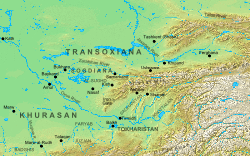- Islamic conquest of Turkestan
-
Arab–Turkic conflicts Part of Muslim conquests 
Map of Transoxiana in the 8th century, where Battle of the Defile took place.Date Between 7th century and 8th century Location Transoxiana, Turkestan, Central Asia Belligerents Umayyad Caliphate
Abbasid Caliphate (after Umayyad period)Göktürk Empire[1]
Türgesh Kaghanate
Khazar Empire
Sogdians[2]Commanders and leaders Qutayba ibn Muslim
Muslim ibn Sa'id
Al-Kharashi
Junayd ibn Abd al-Rahman al-Murri
Sawra ibn al-Hurr al-Abani
Asad ibn Abd Allah al-Qasri
Abd ar-Rahman ibn Rabiah
Al-Djarrah al-Hakami †Kapagan Khan[1]
Suluk Khagan
Irbis
Barjik †
Hazer Tarkhan †
Ras Tarkhan
Alp TarkhanCasualties and losses Heavy Heavy The Islamic conquest of Turkestan or the Arab conquest of Turkestan[3] was the conquest of Turkestan by the Arab-Islamic armies as part of Muslim conquests. Muslims invaded Turkestan and pressured the local Turks living there to become Muslims by converting to Islam.[citation needed]
Contents
Battles between Muslims and Turks
Right after Muslims managed to conquer Persia by Muslim conquest of Persia, they've became neigbours of Turks of Turkestan, whom were predominantly adherents of their Tengrianist faith. The Turks, especially the Turgesh under leadership of Suluk, and Khazars under Barjik have clashed with their Arab neigbours in order to prevent region from Arabization and Islamization. Turgesh-Umayyad Wars and Khazars-Arab Wars were done mostly for region of Transoxiana but however Khazar-Arab Wars also took place outside Turkestan, in places such as Caucasia, North Caucasia, Mosul and city of Atil.
Khazar–Arab Wars
Main article: Khazar–Arab WarsThe Khazar-Arab Wars were a series of campaigns, usually grouped into the First (669) and Second (c.715-737) Khazar–Arab Wars, fought between the armies of the Khazar Khaganate and the Umayyad Caliphate (as well as its Abbasid successors) and their respective vassals.
During the 7th and 8th centuries the Khazar fought a series of wars against the Umayyad Caliphate, which was attempting simultaneously to expand its influence into Transoxiana and the Caucasus. The first war was fought in the early 650 and ended with the defeat of an Arab force led by Abd ar-Rahman ibn Rabiah outside the Khazar town of Balanjar, after a battle in which both sides used siege engines on the others' troops.
Umayyad–Turgesh Wars
Main article: Umayyad–Turgesh WarsSee also: Battle of the DefileSuluk's aim was to reconquer all of Transoxiana from the Arab invaders - his war was paralleled, much more westwards, by the Khazar empire. In 721 Turgesh forces, led by Kül Chor, defated the Caliphal army commanded by Sa'id ibn Abdu'l-Aziz near Samarkand. Sa'id's successor, Al-Kharashi, massacred Turks and Sogdian refugees in Khujand, causing an influx of refugees towards the Turgesh. In 724 Caliph Hisham sent a new governor to Khorasan, Muslim ibn Sa'id, with orders to crush the "Turks" once and for all, but, confronted by Suluk, Muslim hardly managed to reach Samarkand with a handful of survivors, as the Turgesh raided freely.
A string of subsequent appointees of Hisham were soundly defeated by Suluk, who in 728 took Bukhara and later on still inflicted painful tactical defeats such as the Battle of the Defile upon the Arabs, discrediting Umayyad rule and maybe putting the foundations for the Abbasid revolution. The Turgesh state was at its apex of glory, controlling Sogdiana, the Ferghana Valley It was only in 732, that two powerful Arab expeditions to Samarkand managed, if with heavy losses, to reestablish Caliphal authority in the area; Suluk renounced his ambitions over Samarkand and abandoned Bukhara, withdrawing north.
In 734 an early Abbasid follower, al-Harith ibn Surayj, rose in revolt against Umayyad rule and took Balkh and Marv before defecting to the Turgesh three years later, defeated. In 738 Suluk, along with his allies al-Harith, Gurak (a Turco-Sogdian leader) and men from Usrushana, Tashkent and Khuttal to launch a final offensive. He entered Jowzjan but was defeated by the Umayyad governor Asad at the Battle of Sa'n or Kharistan.
Battles between Göktürk Empire and Umayyad Caliphate
The Göktürks also had campaigns against the Arab Muslims.[1] By 705, the Göktürks had expanded as far south as Samarkand and threatened Arab control of Transoxiana.[1] The Göktürks clashed with the Umayyad Caliphate in a series of battles (712-713) in which the Arabs again emerged as victors.[1]
Conquest
After the spread of Islam in the lands of Iran, Muslims and the Tengrianist Turkic peoples became neighbours in the 700's. Qutayba ibn Muslim was assigned by Al-Hajjaj ibn Yusuf, the Muslim viceroy of Iraq, to invade Turkestan. He managed to conquer cities like Sughd, Bukhara, Samarkand, Shash and Farghana. The Muslim expansion resulted in becoming a neighbor of the T'ang Empire.[4] In the Battle of Talas an Arab army decisively defeated a Tang Dynasty force and the Arab dominatation of the region were consolidated.[5]
Islamization
In the Umayyad period, the Arab-Islamic armies managed to defeat Turkic warriors of the region, and conquered the lands where Turks were inhabiting. The Islamization process was slow during Umayyad Caliphate period, but it was accelerated during the Abbasid period. The Umayyad Caliphate were treating non-Arab peoples as second class citizens[6], and many Turkic leaders were executed by them, so therefore Islam didn't get enough conversions by Turkic peoples as Turks were resisting the Islamic aggression. However, during the Abbasid period, Arabs began to respect Turkic peoples and as a result, Islam have began spreading across Central Asia and Turks. In 932, Satuk Bughra Khan of Kara-Khanid Khanate embraced Islam, making him first Turkic khagan to adopt Islam and make it state religion.
References
- ^ a b c d e Göktürk Empire
- ^ History of civilizations of Central Asia, Volume 3, highlighting the words "Sogdian, aid, Turks"
- ^ Four Studies on Central Asia, highlighting the words "Arab, conquest, of, Turkestan".
- ^ Conquest Of Turkestan: 705-714 A.D
- ^ The Empire of the Steppes: A History of Central Asia, highlighting the words: "Battle, of, Talas, arab, domination".
- ^ The Spread Of Islam
Categories:
Wikimedia Foundation. 2010.
